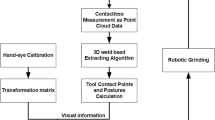Abstract
An efficient approach to surface remodeling and grinding tool-path generation for a large sculptured surface via robotic digitization was developed, and a prototype system was implemented to replace the manual grinding process for large marine propellers. The current manual grinding process removes cusps on the NC machined area and peels the unmachined area; the research focuses on the grinding of the unmachined area of a large marine propeller. A robotic digitization and surface remodeling methodology was developed by the use of a thickness-map that reduces a three-dimensional problem to a two-dimensional problem. Also, the local and global grinding tool-paths are generated on the reconstructed surface based on the thickness-map, and the workpiece is machined by a six-axis articulated robot. The purpose of the research is to construct a prototype system for propeller grinding experiments and further development in Hyundai Heavy Industry, Korea.
Similar content being viewed by others
References
J. W. Park, J. G. Lee and C. S. Jun, Near net-shape five-axis face milling of marine propellers, International Journal of Precision Engineering and Manufacturing, 10(4) (2009) 5–12.
B. K. Choi, J. W. Park and C. S. Jun, Cutter-location data optimization in 5-axis surface machining, Computer-Aided Design, 25(6) (1993) 377–386.
M. K. Lee, B. O. Choi and K. W. Park, Study on propeller grinding path generation. grinding applied by a high stiffness robot, Journal of the Korean Society of Precision Engineering, 14(12) (1997) 56–65 (in Korean).
G. W. Vickers, Computer-aided manufacture of marine propellers, Computer-Aided Design, 9(4) (1977) 267–274.
J. H. Lee and C. S. Lee, A study on geometric modeling and generation of 4-axis NC data for single setup of small marine propeller, Korean Journal of Society of CAD/CAM Engineers, 7(4) (2002) 254–261 (in Korean).
H. C. Kuo and W. Y. Dzan, The analysis of NC machining efficiency for marine propellers, Journal of Materials Processing Technology, 124 (2002) 389–395.
A. M. Ramos, C. Relvas and J.A. Simoes, The influence of finishing milling strategies on texture, roughness and dimensional deviations on the machining of complex surfaces, Journal of Materials Processing Technology, 136 (2003) 209–216.
K. A. White, J. K. Hill and C. G. Jensen, Curvature matched machining methods versus commercial CAD methods, Machining Impossible Shapes (ed. G. J. Olling et al), Kluwer Academic Publishers (1999) 361–165.
B. K. Choi, Surface modeling for CAD/CAM, Elsevier, (1991).
Author information
Authors and Affiliations
Corresponding author
Additional information
Recommended by Guest Editor Dong-Ho Bae
Jung Whan Park is a professor in the School of Mechanical Engineering at Yeungnam University, Korea. He received his BS in Physics, and PhD degree in Industrial Engineering. His research interests include five-axis machining, digital manufacturing, and biomedical software development.
Rights and permissions
About this article
Cite this article
Park, J.W., Cho, H.U., Chung, C.W. et al. Modeling and grinding large sculptured surface by robotic digitization. J Mech Sci Technol 26, 2087–2091 (2012). https://doi.org/10.1007/s12206-012-0520-6
Received:
Revised:
Accepted:
Published:
Issue Date:
DOI: https://doi.org/10.1007/s12206-012-0520-6




